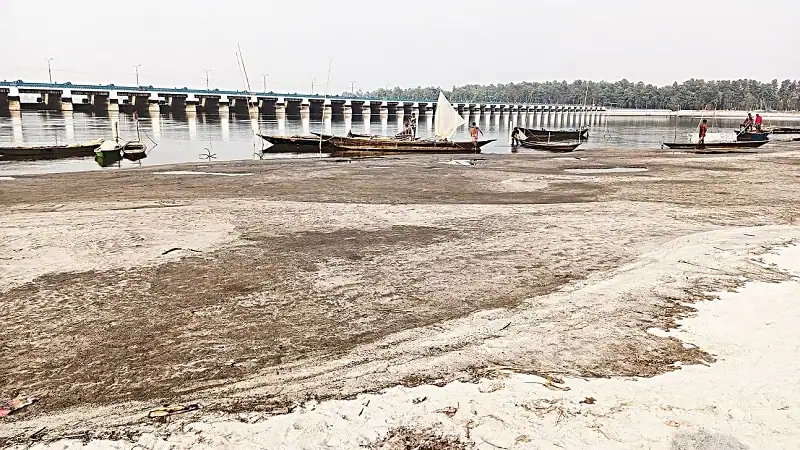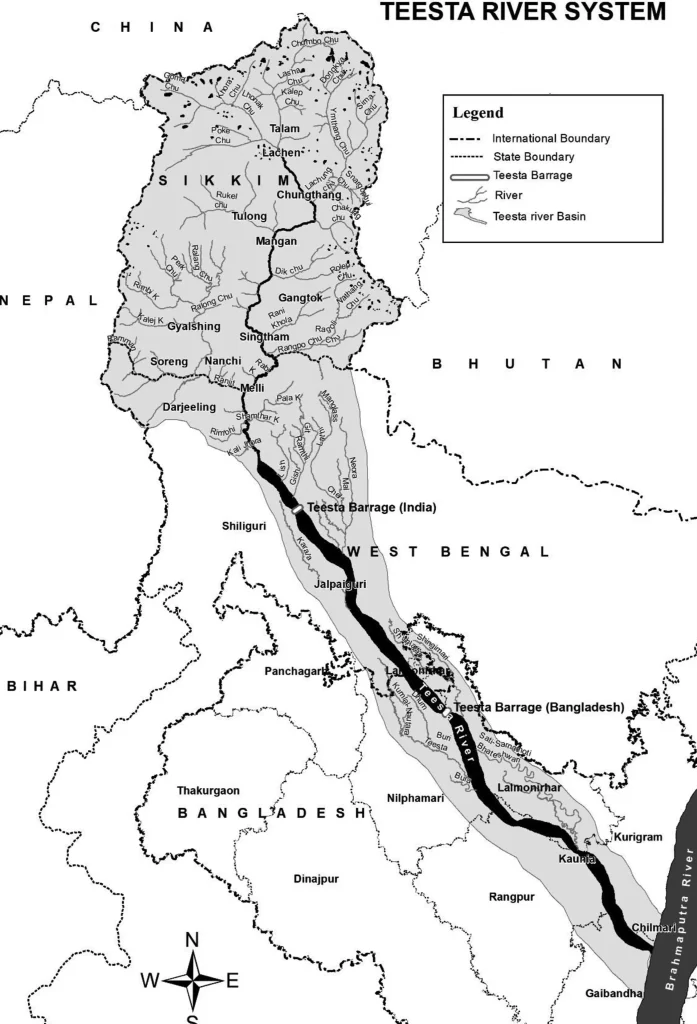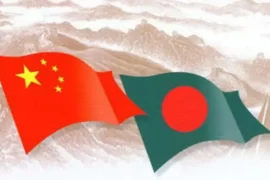The Teesta River flows through India and Bangladesh. It has been at the center of a water-sharing dispute between the two countries for decades. The dispute has its roots in historical, political, and environmental factors. This article will examine the multiple dimensions of the Teesta River water-sharing dispute. We will also assess the suggested solutions to the problem.

Know the Teesta River
The Teesta River is a transboundary river that originates in the Himalayas. It flows through Sikkim and West Bengal before entering Bangladesh. It joins the Brahmaputra River at Phulchari Upazila in Bangladesh. The river has a total length of around 414 km. 141 km of the Teesta flows through Sikkim, 96 km through West Bengal, and 177 km through Bangladesh.
The Teesta River experiences many variations in flow throughout the year. Flash floods occur between May and September, coinciding with the monsoon season. The flow reduces significantly between October and April. The river begins to rise in late March due to snow melting in the Himalayas. Its maximum flow is observed between July and September owing to the heavy rains.
The Teesta River is a major source of water for the people of Sikkim, West Bengal, and northern Bangladesh. The river’s water is used for irrigation, drinking, and hydropower generation. The Teesta River basin has a rich biodiversity. It supports a variety of aquatic and terrestrial ecosystems.
Challenges faced by the Teesta River
The Teesta River is facing several challenges, including water-sharing disputes between India and Bangladesh. The river’s flow has been significantly reduced due to the construction of several dams and barrages on its upstream reaches. This has caused a drastic reduction in the dry season flow, affecting the availability of water for irrigation in both India and Bangladesh.
The Teesta River water-sharing dispute
The Teesta River water-sharing dispute is a long-standing issue between India and Bangladesh over the sharing of the river’s water resources.
The dispute began soon after the construction of the Teesta Barrage at Gajaldoba in Jalpaiguri in 1975. The barrage is popularly known as the Gajaldoba Barrage. The barrage was built to divert water from Teesta through canals on either bank of the river.
Following the construction of the Gajoldoba Barrage, the minimum flow of the Teesta River in Bangladesh has precipitously declined from about 200 cumec (cubic metre per second) to below 40 cumec.
Bangladesh raised concerns about the reduction in the Teesta flow due to the construction of the barrage. Bangladesh argued that the reduction in the river’s flow was affecting the agriculture, drinking water, and livelihoods of the people living in the downstream areas.
So much of the Teesta flow is diverted via the Gajoldoba Barrage for irrigation in West Bengal that there is hardly any dry season flow left to be shared with Bangladesh. It’s because of the entrenched interests of the irrigators in West Bengal that the state government cannot agree to a greater share of the Teesta for Bangladesh, which, in turn, prevents India from accommodating Bangladesh’s demands.
Furthermore, the Indian authorities are planning to build about 15 more diversionary and impounding structures on the upstream reaches of the Teesta and its tributaries. The river’s flow at the Gajoldoba point will, therefore, surely decrease in the future, shrinking further the possibility of dry season flow augmentation in Bangladesh.
The sudden onrush of water, let out by Gajoldoba operators by opening all the vents of the barrage, are causing immense miseries to the people of the basin, destroying their crops and washing away their household assets. There were several such episodes in 2022 alone.
The drastic reduction of the dry season flow, followed by high volumes in the wet season, is destabilizing Bangladesh’s rivers, causing harmful changes in their morphology. In the dry season, the river beds desiccate and harden, reducing the bed scouring that previously took place in the wet season. To accommodate the high volumes of the wet season, the rivers therefore erode their banks, with devastating effects on the lives and properties of the people living in the river basins. Consequently, Bangladesh’s rivers are becoming shallower and wider.
Two more canals under the Teesta Barrage Project
On March 3, 2023, the Bengal Irrigation Department acquired approximately 1,000 acres of land to excavate two additional canals as part of the Teesta Barrage Project, aimed at directing water from the Teesta River for agricultural purposes. The project outlines the creation of a 32km canal, which will draw water from the Teesta and Jaldhaka rivers, extending till Changrabandha of Cooch Behar district. Additionally, a 15 km-long canal will be constructed on the left bank of the Teesta. If this new project is implemented, the water flow of the river at the lower stream will be significantly affected.
The long-awaited Teesta deal
An ad-hoc agreement was signed between Bangladesh and India in 1983, wherein they agreed to share the waters of the Teesta River. As per the terms of the agreement, India and Bangladesh were allocated 39% and 36% of water, respectively, while the remaining 25% was earmarked for the environment. Although the ad-hoc agreement was extended until 1987, the governments of both countries were unable to arrive at a formal treaty concerning the sharing of the Teesta River’s water.
During the Dhaka visit of Indian Prime Minister, Manmohan Singh, in 2011, the signing of a water-sharing agreement regarding the Teesta River was anticipated. However, the signing was abruptly called off at the last minute due to opposition from Mamata Banerjee.
Teesta River Water Sharing Dispute and The Prospects for Regional Cooperation
To resolve the Teesta River water-sharing conflict, it is essential that both India and Bangladesh engage in meaningful dialogue and take steps to address the underlying issues that have fueled the impasse. Regional cooperation is critical to achieving a sustainable solution that benefits all stakeholders. This could involve the development of a basin-wide management plan that takes into account the needs of all countries and communities in the basin, including the indigenous peoples who depend on the river for their livelihoods.
Therefore, it is essential for both countries to work together to find a mutually acceptable solution to this longstanding issue. This will require political will, cooperation, and compromise from both sides. The Indian government should engage in serious dialogue with the state government of West Bengal and other stakeholders in the Teesta basin to find a way to increase the dry season flow of the river.
At the same time, the government of Bangladesh must continue to press for its rightful share of Teesta’s water, while also exploring alternative water sources to meet its growing demand for irrigation and drinking water.
Moreover, both India and Bangladesh must recognize the importance of ensuring the ecological health of the river basin. They should work together to minimize the environmental impact of water diversion and storage structures, as well as address the issue of river bank erosion and sedimentation.
Finally, the international community, including regional organizations and development agencies, should play a constructive role in facilitating dialogue and cooperation between India and Bangladesh on this issue. This can include technical assistance, financing, and knowledge sharing to support sustainable water management practices in the Teesta basin.
Summary
The Teesta water-sharing issue is a complex and multifaceted problem. It requires a collaborative and sustainable solution. India and Bangladesh must work together in good faith to address this issue. They must ensure the equitable and sustainable use of the water resources.








